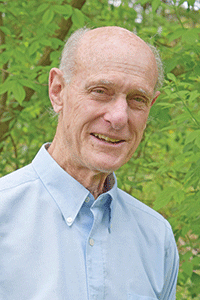Second of a series
One of the first two automobiles in Houston, Minn., was the 1908 International Harvester Auto-Buggy, belonging to Dave Lord. Children were enthralled by that amazing machine, which looked much like a two-seated buggy heretofore pulled by a team of horses. The tires were small and made of hard runner about as big around as a one-inch garden hose. The vehicle had two seats, which were elevated, probably to avoid dust or the splashing of mud or water. There were no fenders.
As recalled from her youth by local historian Ingrid Julsrud, there was only a dashboard up front with the engine beneath the front seat between the two front wheels. The front wheels were only about half as high as the back wheels, which were pulled by the front by a chain that resembled a bicycle chain.
The clanking of the chain, the rattling of the wheels and the sputtering of the engine alerted the children whenever Lord was driving by. They ran to get another look at the fascinating machine in motion.
The other early auto owner was Mr. Miller, a photographer and self-taught mechanic. Behind his first-floor studio, second-floor residence building, he had a large building that later became Orrin Onsgard’s Ford garage and dealership. He owned a red car with a seat closer to the ground and smaller wheels and tires.
In Houston, there was an ongoing discourse on which side was preferable for the steering wheel. Most early autos in the late 1800s had the steering from the right. The immensely popular 1908 Model T was the first Ford with a left-side steering wheel. By 1910, most auto manufacturers were featuring steering on the left.
While driving in a right lane, it was easier for drivers to be on the left side in order to watch for oncoming cars while attempting to pass. And it was more convenient for passengers to board from the sidewalk with the steering wheel out of the way on the left.
Many early autos also had headlights that resembled kerosene lanterns. Julsrud wrote, “I remember seeing someone with an early car lift the lamps off and clean them up and put them back on again. I suspect they got plenty dirty from the splashing up of mud and dust.
“I don’t know if these cars were out much at night. I doubt it. Roads and streets were bad enough to drive on during the daytime.”
This summertime occurrence surely caused local concern. A June 29, 1911 Houston newspaper reported, “A. B. Clark while making a trip from Winona to Houston, last Saturday had the misfortune to have his machine catch on fire about three miles west of town (Houston). The auto was so badly damaged that he was unable to finish the trip. Neither of the two occupants of the machine were injured.’
Percy William “Perk” Steffen, Caledonia editor and columnist wrote, with many a flourish of a phrase, about a wide variety of goings-on, including some early automobile adventures in his hometown. “Henry Seuffert, well tailored and carefully groomed for meeting the public, was a tinsmith of deft artistry. Henry’s desire to maintain a near perfect public image was also reflected in the blooded horses he hitched to buggy and delivery cart. This love of good horse flesh, however, languished markedly after the first automobile chugged its way into the village. He was of the first, joining Dr. William E. Browning, Bill Meitrodt, and Halem Mulnix, in filling the desire to own and operate a gasoline buggy.”
“On an afternoon following Henry Seuffert’s receiving delivery of the chain driven Halliday motor car, he decided to practice driving techniques. With Frieda Seuffert in the back seat, he planned to stay close to the home base, but circle a one block area. Over every foot of the course of travel frantic bedlam resulted from the noise of the chains carrying turning power to the rear wheels and by the explosive un-muffled exhaust of the motor. Horses at hitching posts strained at halter ropes, drivers of harnessed transportation resorted to wrathful cursing as they sought to control frightened animals, barefoot street urchins raced alongside screaming requests for rides in the newfangled contraption, and the diversified clientele of the two saloons in the block rushed to the curb to shout scathing comments unfit for ears of people of genteel breeding.
“In the time required to circle the block three times, Mrs. Seuffert had had enough of roaring horses, profane men and small boys racing along side, their high pitched voices insisting they were faster of foot than the Seuffert gas buggy. As the car neared the Red Front Hardware Store, she shrieked loud enough to be heard above the clamor of the occasion -“Henry! Stop the damn thing. Let me out, I tell you.”
In the early 1920s, William Meyer, a Caledonia grocer, purchased one of the deluxe Ford sedans with every accessory and frill, including lace curtains on the windows. Steffen described in print, “With the car meeting his prevailing desires, Bill drove to the front of the Caledonia Journal and honked loudly in summoning his brother, Leo, whom we all called Judy, to come view the resplendently magnificent creation by human productive ingenuity.
“Judy responding quickly walked slowly around the car, viewing it with critically appraising eyes. As he completed the circle, he opened a rear door and was removing the seat cushion when Bill barked, “What are you doing that for?”
Judy soberly completed his investigation of the area before turning to his brother to comment “You’ve got everything on, or in, this car. I was just trying to find the toilet.”
Sources: Caledonia Pride, 1854-2004 edited by Alan Fleischmann; the Fire Department, and Life in the Houston Area, Vol. I by Michael Olson; Remembering Old Times, Houston During the Post Card Era by Ingrid Julsrud (1993).




Leave a Reply